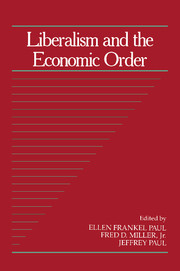Book contents
- Frontmatter
- Contents
- Introduction
- Acknowledgments
- Contributors
- The Social Market Economy
- From Post-Communism to Civil Society: The Reemergence of History and the Decline of the Western Model
- Asymmetrical Reciprocity in Market Exchange: Implications for Economies in Transition
- Institutions, Nationalism, and the Transition Process in Eastern Europe
- The Economic and Political Liberalization of Socialism: The Fundamental Problem of Property Rights
- Democracy, Markets, and the Legal Order: Notes on the Nature of Politics in a Radically Liberal Society
- Liberalism: Political and Economic
- Socialism as the Extension of Democracy
- Liberalism, Welfare Economics, and Freedom
- Some Rules of Constitutional Design
- The Morality of Inclusion
- A New Contractarian View of Tax and Regulatory Policy in the Emerging Market Economies
- Associations and Democracy
- Index
Some Rules of Constitutional Design
Published online by Cambridge University Press: 05 October 2010
- Frontmatter
- Contents
- Introduction
- Acknowledgments
- Contributors
- The Social Market Economy
- From Post-Communism to Civil Society: The Reemergence of History and the Decline of the Western Model
- Asymmetrical Reciprocity in Market Exchange: Implications for Economies in Transition
- Institutions, Nationalism, and the Transition Process in Eastern Europe
- The Economic and Political Liberalization of Socialism: The Fundamental Problem of Property Rights
- Democracy, Markets, and the Legal Order: Notes on the Nature of Politics in a Radically Liberal Society
- Liberalism: Political and Economic
- Socialism as the Extension of Democracy
- Liberalism, Welfare Economics, and Freedom
- Some Rules of Constitutional Design
- The Morality of Inclusion
- A New Contractarian View of Tax and Regulatory Policy in the Emerging Market Economies
- Associations and Democracy
- Index
Summary
INTRODUCTION
Events in both Eastern Europe and the former USSR illustrate the intimate connection between economic and political processes. Those events also remind us that political and economic institutions are human creations, and that when those institutions are poorly designed, politicaleconomic failure is a direct consequence. It is axiomatic, then, that the transition to stable and prosperous societies in those former Communist states requires careful attention to the design and implementation of democratic institutions.
Unfortunately, research grounded in a well-developed framework of scientific discourse that serves as a practical guide to the construction of stable democratic institutions is virtually nonexistent. There are exceptions, the most important being The Federalist Papers and some other parts of the debate surrounding the ratification of the United States Constitution. With respect to the contemporary literature, perhaps the two most evident exceptions are Robert Dahl's Preface to Democratic Theory and William H. Riker's Liberalism against Populism. However, although there are areas of agreement, Dahl and Riker posit diametrically opposite conditions for a stable political system and reach different conclusions about a constitution's role in facilitating stability. Riker argues that “the fundamental method to preserve liberty is to preserve ardently our traditional constitutional restraints.” Dahl, in contrast, asserts that “constitutional rules are not crucial, independent factors in maintaining democracy…. Constitutional rules are mainly significant because they help to determine what particular groups are to be given advantages or handicaps in the political struggle [and] … to assume that [the United States] remained democratic because of its Constitution seems to me an obvious reversal of the relation; it is much more plausible to suppose that the Constitution has remained because our society is essentially democratic.”
- Type
- Chapter
- Information
- Liberalism and the Economic Order , pp. 198 - 232Publisher: Cambridge University PressPrint publication year: 1993
- 4
- Cited by

